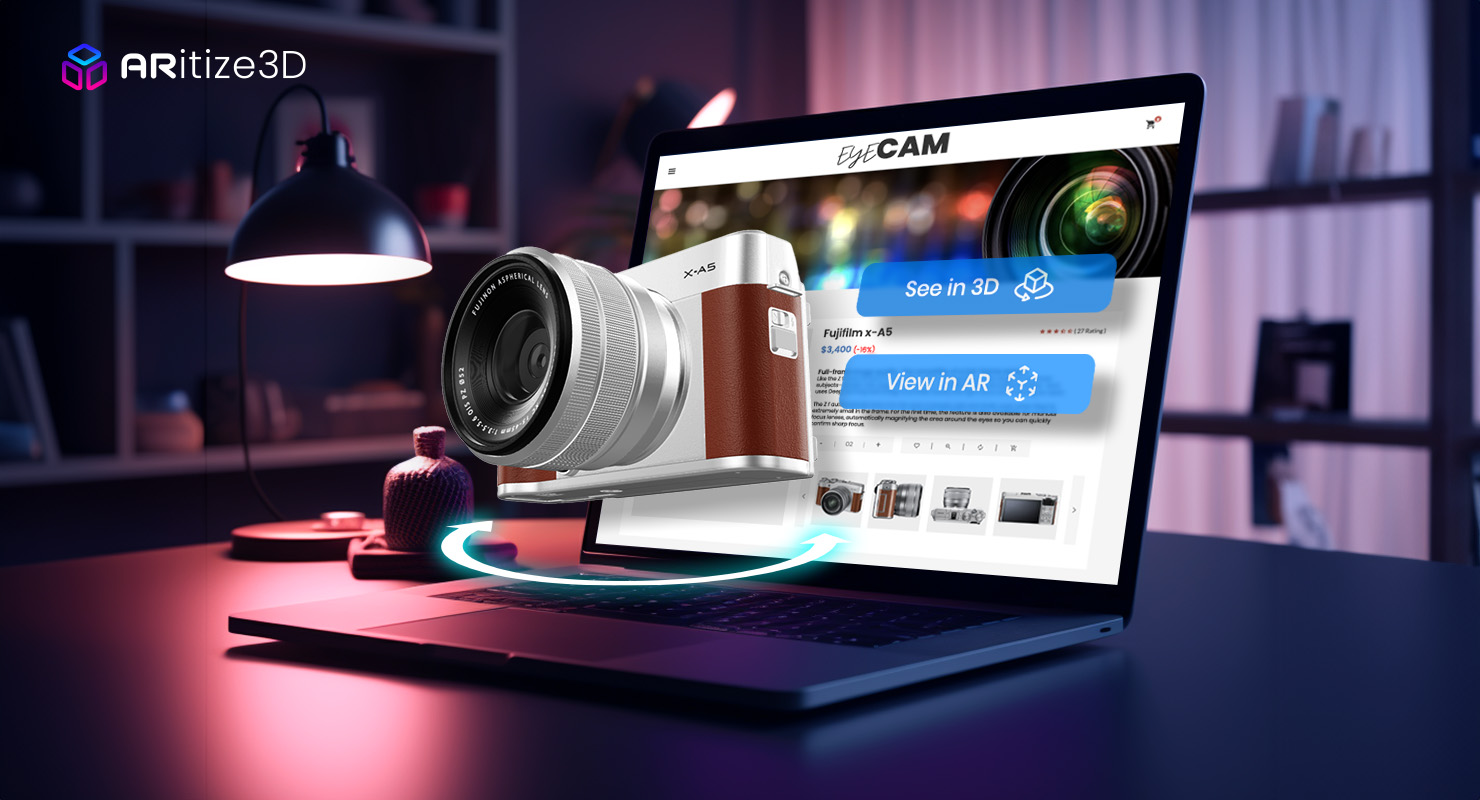For most people, creating or renovating their dream home, office, restaurant, or retail space requires a lot of planning and a considerable investment of time and money. Clients either rely on interior designers and architects to help them design and bring to life their ideas or apply a do-it-yourself approach designing their own space. Building mood boards, crafting color palettes, sourcing furniture and accent decor, and finally placing them in their chosen environment - from research and planning to execution, all stages of decor involve significant time and effort.
When it comes to building beautiful and functional spaces visualizing the space before it’s ready - is key.
Traditionally customers only had the option of viewing furniture in 2D or 3D on their screens before bringing it home. However, the application of augmented reality for interior design and home decor is helping take 3D product visualization to the next level. Using AR, one can create virtual overlays superimposed on the real-world physical environment that can be seen through a smartphone or tablet.
AR allows you to visualize and experience the designed space before it’s actually finished, giving a more realistic experience.
Uses Of Augmented Reality For Interior Design And Home Decor
Immersive Visualization of the Finished Space
Augmented reality visualization is the most exciting feature, enabling customers to actually get a feel of the furniture in their chosen space. Ikea Place brought this experience to the forefront in 2017, allowing users to use an AR catalog to place furniture and decor in their environments. The AR furniture viewer app has resulted in 35% more sales and a 20% reduction in returns for the furniture giant since its launch. ARitize3D enables furniture and home decor retailers to introduce 3D product visualization along with augmented reality visualization into their websites.
Using augmented reality for home decor also allows architects to introduce an interactive presentation of ideas. AR makes it convenient for clients to visualize their space in any style, be it boho, contemporary, cottage chic, minimal, or rustic; any trend can be brought to life using AR visualization.
Customize Furniture and Decor
With a single swipe, tap, or click, customers can change the color of the furniture, the texture of furnishings, and the placement of decor and make modifications to any product to personalize it to their liking using customization features in AR furniture viewers. You can bring your visualizations to life, see how they will actually look when placed in your environment, and make any changes you want virtually before actually purchasing the products. You don’t have to make expensive modifications or return high-end furniture and decor after bringing it home. With AR, customers can stay one step ahead and edit designs with simple clicks and see how they would look from every angle before physically bringing them home. Epsilon’s research shows 80% of customers say they are more likely to purchase products that offer customizations. ARitize3D helps home decor retailers take advantage of this fact by integrating AR customization for products on their websites or apps. Customization puts the customer in control allowing them to personalize products before they shop resulting in higher customer satisfaction.
Spatial Measurement
AR tools like AirMeasure, Amikasa, RoomScanPro, etc can also collect data from real environments. Using the camera on your smartphone, AR tools can help you take measurements of real-world spaces like a virtual measuring tape. Homeowners can be more confident purchasing products once they have the exact dimensions, reducing return rates significantly.
Virtual Showrooms
A virtual showroom is a digital representation of an actual showroom, but rather than being hosted in a tangible physical space, it’s hosted online. Customers can walk through the digital simulation and see the products in 3D and AR. A Shopify survey uncovered that brands that provided AR experiences to customers increased their conversion rates by 94%. AR virtual showrooms with AR visualizations, virtual assistants, audio, and visual experiences add an enhanced layer to the online shopping experience for customers, making it feel like they’re visiting stores from the comfort of their real homes.
Collaboration
Augmented reality visualizations create more vivid previews for customers. This helps improve collaboration between clients, architects, designers, manufacturers, and retail shopping assistants. It helps eliminate doubts and provides true-to-life experiences for buyers. Better collaboration streamlines the workflow while designing any space.
Improving Profitability
Augmented reality for home decor and interior design enhances visualization for customers, improves conversion, reduces return rates, and positively impacts the ROI for interior designers, architects, and online furniture retailers. The average return rate for furniture is 5-7%, but the retail giant, Macy’s managed to bring it down to less than 2% by implementing the ‘try before you buy’ concept integrating AR visualization in their shopping journey.
Competitive Edge
Using augmented reality for home decor helps you provide an elevated and unique customer experience. It personalizes the customer’s journey and gives your business a competitive advantage by offering a rich, immersive experience to buyers.
Improved Guidance
AR helps communicate even the most minute, intricate details in a precise manner. Using AR visualization in the design process, sales assistants and designers can guide their clients to visualize the furniture and decor pieces with crystal clarity. It also enables designers to provide a deeper product understanding and communicate better with their manufacturers using 3D prototypes and AR product demonstrations. Customers can also use AR to help share their ideas with architects and decorators to showcase what they desire the results to look like.
Closing Pitches for Architects and Interior Designers
An interior designer, architect, or home decorator is in the business of making people’s dreams come true. Using AR in presentations - architects and designers can take clients on a journey to another space. Replacing 2D presentations and 3D CAD visualizations that are confined to screens with - audio, visual, and interactive presentations, where customers can see where the couch will be in their living room, play with the color of the curtains, change the decor pieces from an AR catalog and visualize all this like it’s happening in real life in front of them using their smartphone camera. Augmented reality for interior design can undoubtedly help close pitches and accelerate client conversion.
Retaining Customers
Using augmented reality for furniture can not only help accelerate sales but also help in long-term client and customer retention. As per data by Retail TouchPoints, 60% of consumers believe AR would enhance their furniture shopping experience. And 71% of customers say they would shop more often if they used AR. AR increases buyer confidence and eases their doubts. It also engages the customers more, creating a positive buying experience. And happy customers will always come back for more.
Leveraging Augmented Reality For Furniture and Interior Design With ARitize3D
ARitize3D helps create AI-generated, 3D, and AR product models at scale for e-commerce. It is the trusted solution by leading brands for integrating 3D and AR visualizations and product customization capabilities into their website. All you have to do is provide a link to the product’s online URL, a 2D image of the product, or a CAD file, and high-quality photorealistic 3D and AR models will be generated for you. Click here to learn more about ARitize3D.
The Future of Retailing Home Decor
Customer’s expectations from brands have changed. As of 2023, more than 1.4 billion AR user devices are in active use, and considering 61% of customers say they prefer retailers who offer AR shopping experiences, it only shows that augmented reality is an integral tool to leverage in order to satisfy customers. Recently, the social network Pinterest launched Pinterest Lens Camera and Try on Home Decor services - allowing users to visualize furniture in AR at their home before purchasing it. The network reported that users are 5 times more likely to purchase from its AR-viewable pins.
Innovating with AR and making it a seamless part of the customer journey to enable ‘virtual staging’ with augmented reality visualization is the future of retailing home decor.
About Nextech3D.ai
Nextech3D.ai is at the forefront of providing 3D modeling and AR solutions. Nextech3D.ai is democratizing 3D and AR with ARitize3D and ARway.ai, making them more accessible to businesses worldwide and enabling them to evolve their digital and sales ecosystem to stay ahead of the competition in the dynamic, ever-changing consumer landscape.








